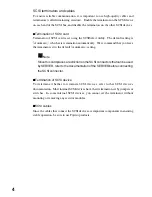
3
E
2. Setup
2.1 Before Connection
Before installing this card and SCSI devices, you should understand the basic concept
of the SCSI, which is described in this section. This information will help you set up
this card and SCSI devices so that they function properly.
SCSI ID numbers
All SCSI devices attached to this card, as well as this card itself, must have a unique
SCSI ID between 0 to 15. The SCSI ID is used for two purposes:
■
Defining each SCSI device present on the SCSI bus
■
Determining the priority of SCSI devices on the SCSI bus
SCSI ID7 has the highest priority for SCSI devices connected to this card. The
priority of the remaining IDs are from 6 to 0 and from 15 to 8 in descending order.
Note
SCSI IDs do not indicate the order in which the cables of SCSI devices should
be connected to this card.
We recommend that you leave the SCSI ID of this card set to its default setting of 7.
If you need to change the SCSI ID of this card, read Section 3.3, "SCSI Card
Configuration (SCSISelect Utility)." To change the SCSI ID of a hard disk drive or
other SCSI device, refer to that SCSI device's documentation.
Note
To boot the system from SCSI device connected to this card, the Boot SCSI
ID in the SCSISelect utility must correspond to the SCSI ID of the SCSI device
to be booted.
When you install two or more SCSI cards in a SERVER, each SCSI card creates a
separate SCSI bus. SCSI ID of devices can be duplicated if they are used on separate
SCSI buses. For example, you can connect two SCSI devices, both having a SCSI ID
of 0, by connecting one SCSI device to one SCSI bus, and the other SCSI device to
the other SCSI bus.
















































